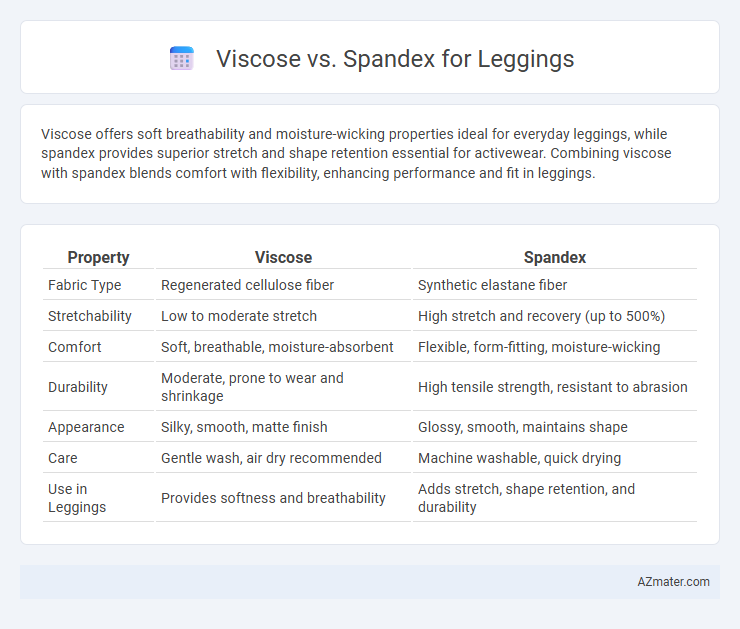Viscose offers soft breathability and moisture-wicking properties ideal for everyday leggings, while spandex provides superior stretch and shape retention essential for activewear. Combining viscose with spandex blends comfort with flexibility, enhancing performance and fit in leggings.
Table of Comparison
| Property | Viscose | Spandex |
|---|---|---|
| Fabric Type | Regenerated cellulose fiber | Synthetic elastane fiber |
| Stretchability | Low to moderate stretch | High stretch and recovery (up to 500%) |
| Comfort | Soft, breathable, moisture-absorbent | Flexible, form-fitting, moisture-wicking |
| Durability | Moderate, prone to wear and shrinkage | High tensile strength, resistant to abrasion |
| Appearance | Silky, smooth, matte finish | Glossy, smooth, maintains shape |
| Care | Gentle wash, air dry recommended | Machine washable, quick drying |
| Use in Leggings | Provides softness and breathability | Adds stretch, shape retention, and durability |
Introduction to Viscose and Spandex Fabrics
Viscose is a semi-synthetic fiber made from cellulose derived from wood pulp, offering a soft, breathable, and drapey texture ideal for comfortable leggings. Spandex, also known as elastane, is a synthetic fiber renowned for its exceptional elasticity, providing superior stretch and shape retention in activewear leggings. Combining viscose and spandex in leggings balances softness with flexibility, resulting in garments that fit snugly while allowing freedom of movement.
Key Characteristics of Viscose
Viscose in leggings offers a soft, breathable fabric that drapes smoothly and provides excellent moisture absorption, enhancing comfort during wear. Its natural cellulose base ensures a lightweight feel with good elasticity, though it lacks the high stretch recovery found in spandex. Viscose leggings often deliver a silky texture and vibrant color retention, making them ideal for stylish, everyday use.
Key Characteristics of Spandex
Spandex is a highly elastic synthetic fiber known for its exceptional stretch and recovery, making it ideal for leggings that require flexibility and shape retention. It provides superior compression and support, enhancing comfort during physical activities while maintaining the garment's durability and resistance to sagging. Compared to viscose, spandex offers moisture-wicking properties and longevity, ensuring leggings perform well through intense workouts and repeated wear.
Comfort Comparison: Viscose vs Spandex Leggings
Viscose leggings offer exceptional breathability and a soft, silky texture that enhances comfort for all-day wear, making them ideal for warm weather or sensitive skin. Spandex leggings provide superior stretch and shape retention, delivering a snug fit that moves with the body while ensuring maximum flexibility during physical activities. Comparing both, viscose excels in moisture-wicking and natural comfort, whereas spandex dominates in elasticity and support, allowing consumers to choose based on their preferred balance of softness versus stretch.
Breathability and Moisture-Wicking Properties
Viscose leggings offer excellent breathability due to their natural cellulose fibers, allowing air circulation that keeps the skin cool and comfortable during wear. Spandex, while highly stretchable and form-fitting, lacks moisture-wicking properties and tends to retain heat and sweat, making it less ideal for high-intensity activities. Combining viscose with spandex can provide a balanced fabric blend that enhances breathability and moisture management while maintaining flexibility.
Stretch and Flexibility Differences
Viscose leggings offer moderate stretch due to their natural cellulose fibers, providing soft comfort but limited elasticity compared to synthetic blends. Spandex, known for its exceptional elastane content, delivers superior stretch and flexibility, allowing leggings to retain shape and accommodate dynamic movements. Combining viscose with spandex enhances fabric resilience and stretchability, making leggings ideal for activewear that requires both softness and high flexibility.
Durability and Longevity
Viscose leggings offer a soft, breathable feel but tend to have lower durability due to their natural fiber composition, making them prone to pilling and wear over time. Spandex, known for its exceptional elasticity and resistance to deformation, provides superior longevity and shape retention in leggings, ensuring they maintain fit even after multiple washes. Combining viscose with spandex blends can enhance durability while preserving comfort, striking a balance between softness and endurance for long-lasting activewear.
Care and Maintenance Requirements
Viscose leggings require gentle washing in cold water and should be air-dried to prevent fabric shrinkage and maintain softness, while spandex leggings need to be washed in cool water and preferably inside out to preserve elasticity and color vibrancy. Avoid using bleach or fabric softeners on both fabrics as they can degrade fibers and reduce lifespan. Proper care extends the durability of viscose's breathable texture and spandex's stretchable fit, ensuring leggings retain their shape and comfort through multiple wears.
Sustainability and Environmental Impact
Viscose leggings, derived from cellulose from wood pulp, offer a biodegradable alternative but involve chemically intensive processes that can contribute to deforestation and water pollution if not managed sustainably. Spandex, a synthetic polymer made from petrochemicals, poses environmental challenges due to non-biodegradability and reliance on fossil fuels, leading to significant carbon emissions during production. Choosing sustainably sourced viscose with certifications like FSC or opting for recycled spandex blends helps reduce environmental impact in legging manufacturing.
Which Fabric is Best for Leggings?
Viscose leggings offer a soft, breathable feel ideal for everyday comfort but lack the stretch and durability needed for active wear. Spandex, known for its exceptional elasticity and shape retention, provides superior flexibility and support during workouts or high-movement activities. Choosing spandex-based leggings ensures better performance, longevity, and a snug fit, making it the best fabric option for leggings designed for both exercise and extended wear.

Infographic: Viscose vs Spandex for Legging
 azmater.com
azmater.com